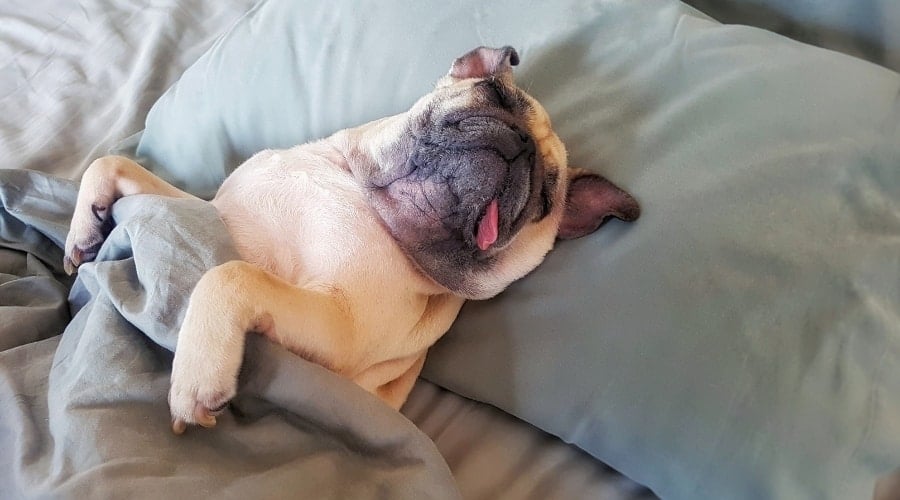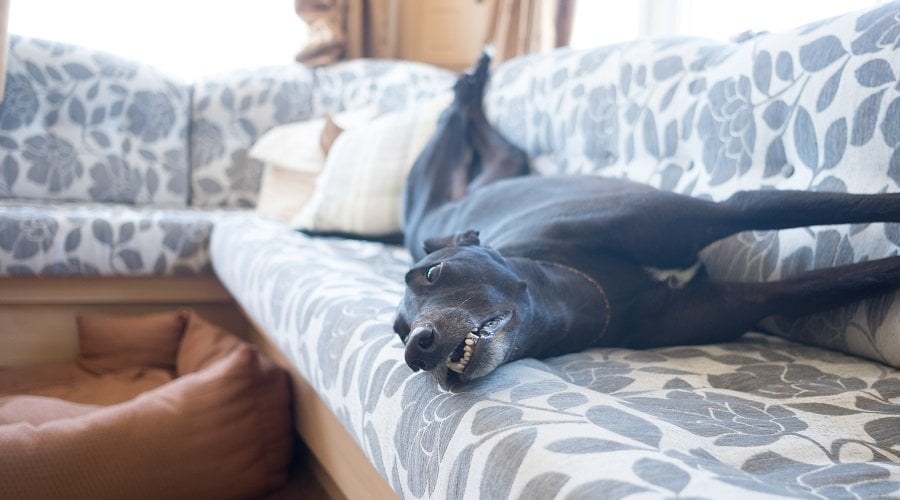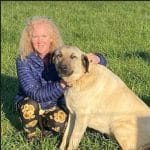The label “lazy” can mean many things. When an individual dog is called lazy, it could mean that this dog is advancing in years, in ill health, or just remarkably calm. It could even be that he’s a breed that sleeps during the day because he remains vigilantly on guard all night. If you’re in the market for a new best friend, decide why a breed deemed “lazy” appeals to you so you can find a pup likely to be happy and make you happy in your unique situation.
What do we mean when we call a dog lazy, anyway? Mirriam-Webster defines laziness as “disinclined to activity or exertion. Not energetic or vigorous.” Even that definition leads in two directions. The first half of the definition suggests a dog that uses its energy as efficiently as possible throughout the day. The second, implying a lack of vigor, indicates the dog has lost strength or is in poor health. Consider these two separate meanings when someone calls a dog “lazy.”
If an individual dog is called lazy, make sure he’s healthy. Lazy usually has a negative connotation. If a once vigorous dog becomes unusually sluggish and isn’t due to natural aging, plan a trip to the veterinarian. When an entire breed is labeled lazy, something about it has earned the term. The key to finding the right dog for your situation is knowing what sort of “lazy” appeals to you in a pet.
Adopting A Senior Dog

If a calm, quiet dog with a low energy level best suits the needs of your family or fits your lifestyle, adopting a senior dog may be an excellent option. Senior dogs may end up at local shelters for reasons beyond their control, hoping for a second chance with a new family. Although the appeal of that adorable frisky puppy is strong, there are many reasons to choose a more mature individual.
If you choose a puppy from a calm breed, you could still have chosen a particularly active individual. When you observe a senior, you see a personality that has developed over time and is relatively stable. You’re less likely to get a live wire as a pet when you were hoping for a quiet cuddle bug.
Adopting a senior dog makes it easier to find a calm individual and gives a pup who may be down on his luck a soft landing in his golden years. A senior may have a lower chance of being adopted from a shelter, so if you can provide a loving home and appropriate veterinary care, finding your new best friend may save his life.
Lazy Versus Calm
The word lazy has a negative connotation, so calm or sedate is a better term. Anyone looking for a new family member must consider the family vibe. Some families are active outdoorsy groups where a high-energy running buddy or flyball partner will feel at home. Other families, however, are quiet by nature. Although every animal in the household needs attention and exercise, some breeds are generally more comfortable in a low-energy situation. Knowing what breed is a fit for your quiet home is the first step in a long, happy partnership with the newest member of your family.
What Characteristics Help Keep Dogs Calm

Suppose you’re specifically looking for a pet that will enter your home with hardly a ripple on the surface of your serene situation. In that case, you should consider non-canine options and think long and hard before bringing home a young puppy. While most pets settle into a predictable routine as they grow up, puppyhood is chaotic. No matter the breed, a puppy will make messes and mistakes. Even the initial task of housebreaking your pup takes time and energy.
If the thought of a bit of chaos and some minor to significant messes troubles you, it may not be the right time in your life for a pup. You may be happier with a serene aquarium full of fish or a bird cage with finches who sing but require little one-on-one interaction. Even then, there’s no such thing as a maintenance-free pet. If you want to be entirely hands-off, a pet is not for you.
The Gentle Giant
A dog labeled lazy may be exceptionally gentle-natured. It isn’t that he is too lazy to react, but may have a higher tolerance for noise and activity than other breeds. Several large breeds are exceptionally gentle with small children and small livestock. They are often called lazy by people who don’t understand them. They are patient, resting during the day, and remaining vigilant to guard their charges at night. Giant breeds require special care due to their size and should be allowed to mature slowly to keep them as healthy as possible.
Bernese Mountain Dog

The Bernese Mountain Dog is willing to bounce around and play like a smaller dog, but his calm devotion to family is the hallmark of his personality. Much like Newfoundlands, they should be primarily indoor dogs. They enjoy the outdoors and handle cold weather well. Solid companions for long walks or hikes, Berners are willing to pull a cart in harness.
Although they are calm and quiet-natured at home, they enjoy active sports. Berners excel at agility, herding, obedience, and tracking competitions. A half-hour of moderate exercise daily is enough to keep them happy and healthy.
Great Pyrenees

The Great Pyrenees is commonly used as a livestock guardian dog. Farmers may use Pyrs to guard herds of sheep, goats, chickens, or even more exotic animals such as alpacas. In pairs or teams, Great Pyrenees work together to chase away predators and, when appropriately raised with the stock they guard, are gentle even with newborns. Pyrs are known for being calm and peaceful with children, too. Great Pyrenees may be considered lazy because they tend to actively patrol at night and hence rest or sleep most of the day.
Other similar breeds with these characteristics may be misconstrued as lazy by anyone seeing them resting during the day. These livestock guardian dog breeds (LGDs) are Anatolian Shepherds, Akbash, Maremmas, Karakachan, Kangals, and Kuvasz. Other less common LGD breeds include the Komondor, Polish Tatra, Pyrenean Mastiff, Sarplaninac, Armenian Gampr, Central Asian Shepherd, and Caucasian Ovcharka.
Newfoundland

Although the Newfoundland is a giant breed, he is a gentle giant indeed. His devotion to his children characterizes his personality. A multipurpose dog at home in land and water, Newfoundlands could be considered lazy because they require surprisingly little exercise for their size. Comfortable as indoor dogs, they also appreciate time outside.
Newfies are better suited to cold weather than hot, and they love swimming. The breed is famous for being water rescue dogs, but they’ll even pull a cart. These stately dogs are high maintenance due to their size and grooming needs, but not for their temperament. Their calm, quiet personalities make them excellent indoor dogs for a home with enough space.
Bulldogs & Other Brachycephalic Dogs

Some breeds may be labeled lazy because they have conformational traits that make them less able to withstand exercise than other breeds. Brachycephalic means short-headed and refers to the shortened snouts and flatter faces of breeds like English and French Bulldogs, Pugs, Bull Mastiffs, Boston Terriers, Boxers, Lhaso Apsos, Shih Tzus, and Pekingese. Although not all dogs with this short snout and flat face combination have health problems, many do, and most, need minimal exercise and some protection from overheating.
Four abnormalities can cause brachycephalic airway syndrome, and a dog may have one or more. The abnormalities are stenotic nares, elongated soft palate, hypoplastic trachea, and everted laryngeal saccules. Stenotic nares are smaller nostrils that can restrict airflow. An elongated soft palate means the tissue on the roof of the mouth extends too far down the back of the throat, which can block the windpipe (trachea). A hypoplastic trachea is narrower than a normal airway. While everted laryngeal saccules are usually due to any combination of these conditions causing the dog to struggle to breathe, they can further obstruct an already narrow airway.
When a dog suffers from brachycephalic airway syndrome, symptoms may include noisy breathing, snoring, gagging, and vomiting. Also included, however, are lethargy and exercise, and heat intolerance. If your dog has these symptoms, exercise restrictions may be necessary to lessen his symptoms. Unfortunately, he is probably not normally active if he hasn’t been breathing easily. Many of these breeds are labeled low energy, or lazy but compromised breathing may be the actual problem.
English Bulldog

Bulldogs aren’t overtly lazy and will benefit from gentle exercise to keep them fit and trim. They don’t handle heat or humidity well due to their brachycephalic profile. Depending on where you live, your climate may necessitate your Bulldog to spend most of his time indoors in the air conditioning when summer comes.
French Bulldog

Their calm, even temperament makes them ideal family pets. They don’t bark to excess and handle dwelling in the city well. Adaptable to life with individuals or families, they need less outdoor exercise than most family-friendly breeds. Frenchies, like other brachycephalic breeds, may have breathing problems and not handle heat, humidity, or overexertion well. They aren’t necessarily lazy but are relatively low-energy and easy to manage.
Pekingese

Although choosing an individual with wide nostrils may help with some breathing problems, ensure he doesn’t overheat. His flat face still affects his breathing and hence, his energy level. Pekes don’t require a lot of exercise and are relatively sedate companions. They benefit from a leisurely daily stroll and cannot handle excessive exercise or hot temperatures.
Pugs

The happy-go-lucky Pug comes with the same exercise caution as other brachycephalic dogs. Although they are playful, they don’t handle heat well, and their facial profile can predispose them to respiratory difficulties. When it is warm or humid out, Pugs fare better in an air-conditioned indoor setting. Light exercise helps keep him from becoming overweight because he’s a couch potato.
Quiet Hounds & Spaniels
Dogs bred as hunters aren’t usually considered lazy because they need plenty of energy to do their job. A few hunting breeds, however, are quiet by nature and enjoy a good nap as much as they enjoy the hunt.
Bassett Hound

While some call Basset Hounds lazy because they don’t ever seem to be in a hurry, Bassets have considerable endurance. They can track over great distances, if not at high speed. As pets, Bassets’ exercise needs are moderate. A daily walk will usually keep them in good shape, although they tend to put on excess weight.
Greyhound

They need a daily walk and the occasional freedom to run and burn off some steam, but then they are content to relax quietly in their homes alongside family. Greyhounds do have a high prey drive and will give chase after other small animals and even cats, so don’t let their seeming laziness fool you.
Although Greyhound racing is becoming illegal in more states, retired Greyhounds still need a soft place to land. Adopting a Greyhound may be the perfect option if you want a peaceful but elegant companion. Adoptable Greyhounds may not be cat safe, so if you already have a cat, the safest bet is to get a Greyhound pup to raise with the adult cat.
Whippet

Also, like Greyhounds, they are social dogs who don’t like to spend much time alone. They love long, leisurely walks and need space to stretch their legs and run from time to time. If they have adequate exercise and aren’t left home alone for extended periods, Whippets fit well in a quiet household and could be called lazy because they’re generally content to sleep much of the day on the couch or in their crate.
If loud or boisterous children disturb a Whippet, the dog will typically look for a place to hide instead of growling or snapping. They have a high prey drive due to their background as hunting dogs. If you have a cat in the home, look for a young pup, and don’t assume being socialized to the cat in the house means your Whippet (or other sighthounds) won’t chase and harm other cats.
Final Thoughts
When you seek out a “lazy” dog as a companion, be sure you’re ready to do the work that dog ownership requires. No matter how calm your canine is, you must walk him daily and care for him properly. It requires time, effort, and money to raise even the calmest of dogs properly.
A senior dog may be the perfect fit for your quiet household. Visit your local shelters and ask if there’s a healthy senior, purebred, or mixed breed available for you to meet. Have a vet check done to be sure your new best friend’s health is good and his calm attitude is not due to an underlying health problem. Find the right breed and the right individual to fit your quiet lifestyle.





